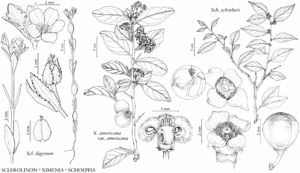Difference between revisions of "Ximenia americana var. americana"
FNA>Volume Importer |
FNA>Volume Importer |
||
| Line 23: | Line 23: | ||
|elevation=0–30 m. | |elevation=0–30 m. | ||
|distribution=Fla.;Mexico;West Indies;Central America;South America;Asia;Africa;Indian Ocean Islands;Pacific Islands;Australia. | |distribution=Fla.;Mexico;West Indies;Central America;South America;Asia;Africa;Indian Ocean Islands;Pacific Islands;Australia. | ||
| − | |discussion=<p>R. A. DeFilipps (1968, 1969) recognized three varieties of Ximenia americana, with the pantropical var. americana occurring in peninsular Florida. The other varieties occur in Argentina (var. argentinensis DeFilipps) and Africa (var. microphylla Welwitsch ex Oliver). From greenhouse pot studies, DeFilipps (1969b) determined that X. americana is able to exist without a host, thus it should be considered a facultative hemiparasite. The flowers are fragrant and presumably insect pollinated. The anthers dehisce before the flower bud opens and the adaxial hairs on the petals may serve to present the pollen (P. B. Tomlinson 1980). Variety americana shows different growth forms on different substrates; plants on sandy coastal areas are sprawling shrubs with orbiculate, fleshy leaves, whereas plants in forests and scrublands are trees with oblong to oblanceolate, thin leaves.</p><!-- | + | |discussion=<p>R. A. DeFilipps (1968, 1969) recognized three varieties of <i>Ximenia americana</i>, with the pantropical <i></i>var.<i> americana</i> occurring in peninsular Florida. The other varieties occur in Argentina (var. argentinensis DeFilipps) and Africa (<i></i>var.<i> microphylla</i> Welwitsch ex Oliver). From greenhouse pot studies, DeFilipps (1969b) determined that <i>X. americana</i> is able to exist without a host, thus it should be considered a facultative hemiparasite. The flowers are fragrant and presumably insect pollinated. The anthers dehisce before the flower bud opens and the adaxial hairs on the petals may serve to present the pollen (P. B. Tomlinson 1980). Variety americana shows different growth forms on different substrates; plants on sandy coastal areas are sprawling shrubs with orbiculate, fleshy leaves, whereas plants in forests and scrublands are trees with oblong to oblanceolate, thin leaves.</p><!-- |
| − | --><p>Ximenia inermis Linnaeus, an illegitimate and superfluous name, pertains here.</p> | + | --><p><i>Ximenia</i> inermis Linnaeus, an illegitimate and superfluous name, pertains here.</p> |
|tables= | |tables= | ||
|references= | |references= | ||
| Line 48: | Line 48: | ||
|publication year= | |publication year= | ||
|special status=Selected by author to be illustrated | |special status=Selected by author to be illustrated | ||
| − | |source xml=https://jpend@bitbucket.org/aafc-mbb/fna-data-curation.git/src/ | + | |source xml=https://jpend@bitbucket.org/aafc-mbb/fna-data-curation.git/src/8f726806613d60c220dc4493de13607dd3150896/coarse_grained_fna_xml/V12/V12_663.xml |
|genus=Ximenia | |genus=Ximenia | ||
|species=Ximenia americana | |species=Ximenia americana | ||
Revision as of 14:48, 18 September 2019
Shrubs or small trees, to 12 m. Leaves: blades elliptic, lanceolate, ovate, obovate, or orbiculate, 1.3–10 cm, apex retuse, obtuse, or acute, with or without 0.5–1 mm mucro; venation eucamptodromous. Inflorescences 2–10-flowered; peduncles 1–15 mm. Pedicels 4–12 mm. Flowers: sepals 0.5–4 mm, ciliate; petals yellow, pale yellow, yellowish green, or white, 4.5–12 mm, recurved at maturity; stamen filaments 2.5–6 mm; anthers 1.5–4.5 mm; style 2.5–5.5 mm. Drupes 1–3.5 × 1.1–3 cm. Seeds 1.5–2.5 × 1.1–2 cm. 2n = 24.
Phenology: Flowering Apr–May(–Nov); fruiting year-round.
Habitat: Pinelands, hammock margins, coastal scrub, coastal sand dunes.
Elevation: 0–30 m.
Distribution
Fla., Mexico, West Indies, Central America, South America, Asia, Africa, Indian Ocean Islands, Pacific Islands, Australia.
Discussion
R. A. DeFilipps (1968, 1969) recognized three varieties of Ximenia americana, with the pantropical var. americana occurring in peninsular Florida. The other varieties occur in Argentina (var. argentinensis DeFilipps) and Africa (var. microphylla Welwitsch ex Oliver). From greenhouse pot studies, DeFilipps (1969b) determined that X. americana is able to exist without a host, thus it should be considered a facultative hemiparasite. The flowers are fragrant and presumably insect pollinated. The anthers dehisce before the flower bud opens and the adaxial hairs on the petals may serve to present the pollen (P. B. Tomlinson 1980). Variety americana shows different growth forms on different substrates; plants on sandy coastal areas are sprawling shrubs with orbiculate, fleshy leaves, whereas plants in forests and scrublands are trees with oblong to oblanceolate, thin leaves.
Ximenia inermis Linnaeus, an illegitimate and superfluous name, pertains here.
Selected References
None.
